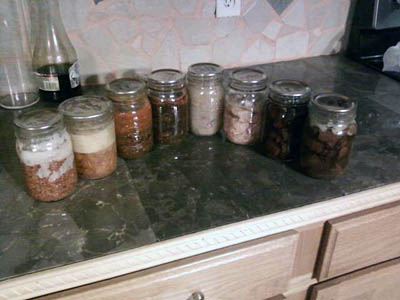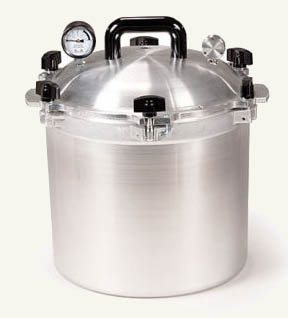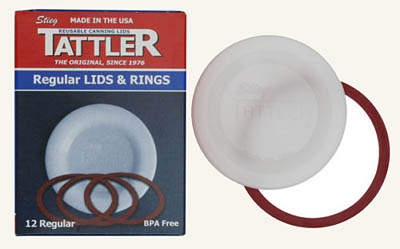Preserving Food in a Grid-Down Situation

Guest post: by Christine Coburn
We all know how possible a grid down scenario is. While we have been stuffing our pantries and freezers with food to sustain us, what happens when there is no electricity to run that freezer? If it is winter time in a northern place then it would be fine and we could use Mother Nature. But what if you live in a southern area where the temperature does not remain below freezing?
One solution would be to home-can your food. Let’s start out by talking about the equipment needed. First thing you would need a good quality canner. They can be purchased pretty much anywhere. Most require a rubber gasket between the lid and the pot in order to produce a seal and build the required pressure in order to raise the temperature to a point that pathogens are destroyed inside your jars. But then what do you do when the gasket fails (they generally last 3-5 years) on your canner and you have no store to go buy another or the internet to order one? My suggestion would be to invest in a canner that does not require a gasket. There is one brand of canner that does not require a gasket. It is the “All American Canner”.
All American Pressure Cooker/Canner
Read more: All American Pressure Canner That Will Last Forever…
They are quite pricey to buy initially but when you figure many years of service without replacement gaskets the price goes down. This canner has a machined rim that is so precise that it does not require any kind of gasket. You have to be careful to not boil it dry and warp it. But with careful use and care it should last your lifetime. There are several listed on eBay.
Then there are those pesky metal lids that can only be used one time. Wal-Mart generally carries these lids. I say generally because last fall my Wal-Mart in our town decided it was past canning season and sent all of theirs back to the warehouse. Then when I went to the supercenter in the next town they were out. I finally found some at the hardware store in town. The prices have also gone up on these. They were .99 cents a dozen a couple years ago and now the cheapest I can find them for is $1.63 when Wal-Mart has them and $2.49 at the hardware store.
So what happens when the grid is down and no stores or internet is available to buy any? The solution to this is tattler reusable lids.
Tattler Reusable Wide Mouth Canning Lids & Rubber Rings
I have some and plan to buy a lifetime supply soon. I have experimented with them and they have proved reliable over and over. They are pricey for the initial investment but over the long run they pay for themselves quite quickly. They are a 2 piece plastic lid with a rubber gasket. As long as you do not damage the gasket they will work over and over. You have to be careful when opening your jar so that the gasket does not get cut with your opener. They are also tricky in that you have to get used to not tightening the rings down on them until after processing. The trick is to tighten the ring down and then back it off about ¼ of an inch. Then you process according to recommended times and pressures. When you take the jars out of the canner use mitts and tighten each ring down on the jars. Set your jars on a towel and allow them to cool. After they have cooled completely then you can remove the rings. The only other drawback is that you can not write on them. Since they are reusable writing on the lids would cause a problem the next time you used them. So after they are cool and you remove the rings make sure the jars are clean and place a small piece of masking tape on the lid and write on it. Or you can write on the jar itself with a magic marker as this will wash off the glass. You can get them in a bulk deal for about .50 cents a lid. Since the metal ones are about .20 cents a lid you can see how fast they would pay for them selves. You can look at the tattler website www.reusablecanninglids.com If you email them they will send you a sample.
The other equipment you would need is reusable and you would not need to worry so much about replacements. They are:
Jar lifter
Small pot for boiling the lids
Jar funnel
Water bathing pot for processing pickles and fruit, you can also use your canner without the lid for this, but I like a separate pot to water bath in.
Pot holders or oven mitts
A large ladle for filling jars
A canning book (I like Putting Food By) There are many different ones available.
And of course the food you are canning (inserted per my 10 year olds request)
Now that we got the boring equipment part out of the way we can move on to the good part…
There is a great satisfaction to having your cabinet full of what I call convenience foods. I like to can food in a way that I can open the jar, heat it up and Presto dinner is ready. I love to make soup and when I do I make it 5 gallons at a time… I do not add any pasta to it when I make the big batch then I will remove only what we are going to eat for that meal to add the pasta. (Pasta does not can well it only gets mushy). Then I can all of the leftovers in quart jars. Meat loaf, meat balls, barbecued meat, roast in gravy, taco meat, spaghetti sauce with the meat and even left over gravy in jars makes for a very speedy meal and can even be prepared by the less culinary gifted people in your home should you be unable to cook. Remember that what ever you can always process it for the recommended amount of time for the ingredient requiring the longest processing time. For example I made venison soup a few days ago. It had venison, barley and vegetables in the soup. The venison would require the longest processing time, (90 minutes at 15 lbs for our altitude and for quart jars). So that is what the soup got processed for.
As you can see from the above picture the grease will float to the top of the jar and get hard when it cools. Then when you open the jar it is very easy to remove the fat with a spoon. The meat is from left to right: hamburger, Meat loaf, Taco meat, BBQ Chicken, Roast pork and gravy, canned boneless pork, Ham chunks, boneless beef chunks.
When you can meat it does change the flavor and texture a bit. My husband does not care for the canned hamburger but it is a good way to preserve it when there is no freezer. Using this meat is as easy as opening the jar and draining the liquid. You can process meat either hot pack (already cooked) or raw pack. In the above pictures the beef, ham and pork are raw packed, the others were cooked first. The roast and gravy was leftover from a large roast I cooked. Canned chicken flakes easily for making things like enchiladas and you can buy the lesser cuts of beef that would normally be tough; after you can them they are very tender.
Canning meat (Raw pack)
Raw pack is the easiest way to can meat. Simply cut the meat into chunks and pack into the jar leaving about an inch of headspace (the distance from the top of the meat to the top edge of the jar). Wipe the rim of the jar (you must make sure there are no food particles, grease or chipped rims or it will not seal). Place a boiled lid on top and screw on a ring. Then process at the recommended time and pressure. We are at a little over 1000 feet. I process meat for quarts 90 minutes at 15 lbs and pints for 75 minutes at 15 lbs. You can NOT process meat in a water bath. It MUST be pressure canned. When processing raw meat you do not add any liquid. The broth is made as the meat cooks in the jars. Begin timing after your canner has reached the correct pressure per your specific canners instructions. After the timing is over slide your canner to a cool side of the stove and allow it to cool. Do NOT try to reduce the pressure rapidly by running water on it or helping the pressure to escape. This will cause seal failure. After the canner has cooled and there is no longer any pressure inside it then remove the weight and lid. Using a jar lifter remove the jars to a towel on your counter. Remember they are VERY hot at this time and you will see the contents still boiling. If you are using Tattler lids this is the time to tighten the bands down. After the jars have cooled off (over night) then remove the lids and wash the jars. The jars may have grease on the outside of them from processing. Always write on the lid or tape what the contents are and the month/year of processing. Home canned meat should have a shelf life of about 5 years if done properly.
Canning meat (Hot pack)
This is the way you would can any leftovers. Heat what ever you are going to process up (Soup, meat and gravy, taco meat, etc). Then using the jar funnel ladle the food into the jar leaving about 1 inch of headspace. Then follow the directions above. Remember to always process for the time required to process the longest amount recommended for any one ingredient.
Canning Meatloaf (Raw pack)
You must use wide mouth pint jars for this. Otherwise the neck of the jar will not allow your loaf to slide out. Do not add eggs or fillers (oatmeal, bread crumbs, etc). Mix your ground meat with the seasonings you wish. I mix sausage and hamburger together with a can of drained diced tomatoes and a bit of Italian seasoning.
Then pack the mixture into the jar leaving an inch of headspace. Wipe the rim. Place on lids and rings then process the recommended time/pressure. When it is done you will have a nice loaf of cooked meat in a broth with fat ion top. When you are ready to eat it open the jar and drain the liquid. I like to slice the meatloaf to make sandwiches.
Canning Meat Balls (hot pack)
Make your meatballs (mix meat and seasonings). Do not add any eggs or fillers. Bake them in the oven to brown them. Then place the balls into jars and cover with liquid (I use half strength V8 juice) Process the recommended time/pressure. The meat balls make a great snack for kids and easy to make meat ball subs, spaghetti, etc.
Canning soup or roast (Hot pack)
Make your soup or roast. Make sure if you are canning roast that it is cut into small enough pieces to fit into the jar and then come back out easily. Do not add any pasta to your soup prior to canning. If you are going to want pasta in your soup then wait and add it after you open the jar. It is very easy to open the jar heat it to boiling then add a handful of noodles and cook them in the broth. If you try to can pasta it only gets mushy.
Canned Gravy: Depending on what you use to thicken your gravy it may thin out and need to be thickened with corn starch after you open the jar. Corn starch will break down if it is cooked too long so corn starch thickened gravy will also thin back out with processing.
You can even can Bacon slices, bacon bits, etc. What you put into jars really is as great as your culinary skills and imagination. It is a great way to utilize leftovers so that they are not wasted and a great way to add to your food stores without spending a lot of money on store bought canned meat. Just remember to always process the safe time and pressure for your altitude for the ingredient that requires the longest processing. Also remember that spices tend to get stronger after canning. So if you think there is a little too much oregano in your meat balls you need to add more meat before you process or your meat balls will really have too much oregano when you are done.



